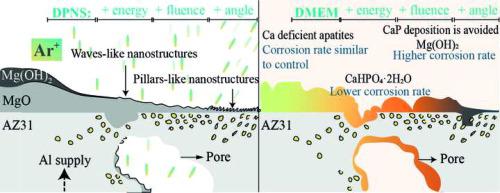Applied Surface Science ( IF 6.7 ) Pub Date : 2021-02-25 , DOI: 10.1016/j.apsusc.2021.149388 Viviana M. Posada , Ana Civantos , Juan Ramírez , Patricia Fernández-Morales , Jean Paul Allain

|
Directed plasma nanosynthesis (DPNS) is a plasma-based surface modification process used to provide high-fidelity bioactive and bioresorbable interfaces for Mg-based foams having an average 500-μm pore size and containing main components of Al, Zn and Ca at bal., 3.3%, 1.11%, and 0.21%, respectively. Correlations of incident particle energies of 400–700 eV and room temperature, normal and off-normal incidence angles of 0° and 60°, respectively, and high-ion fluence conditions are combined to elicit a bioreactive Mg-foam surface. H2 evolution and pH levels of irradiated and non-irradiated Mg-foams were examined and correlated to the DPNS parameters. In situ X-ray photoelectron spectroscopy and focused ion-beam results have shown that energies of ∼400–700 eV can control surface topography and composition, which, in turn, controls the foam-corrosion mechanism. Samples are immersed in Dulbecco’s modified eagle media, and a synergistic reaction is found in which the irradiated samples enhance the formation of calcium–phosphate (CaP) phases to CaP ratios close to the hydroxylapatite phase that enhances bone-tissue regeneration. These results lead to a surface modification strategy that adjusts the interaction of the material and the environment without using a coating that could affect the geometry and the bulk properties of the porous material.
中文翻译:

量身定制的具有定向等离子体纳米合成功能的可生物吸收的镁基支架,可增强骨整合和可调节的吸收
定向等离子体纳米合成(DPNS)是一种基于等离子体的表面改性工艺,用于为平均孔径为500μm的镁基泡沫塑料提供高保真度的生物活性和生物可吸收性界面,并且在Bal处包含Al,Zn和Ca的主要成分。 ,分别为3.3%,1.11%和0.21%。将400-700 eV的入射粒子能量与室温,法线入射角和法线入射角分别为0°和60°以及高离子通量条件的相关性结合起来,以产生具有生物反应性的Mg泡沫表面。高2检查了辐照和未辐照的Mg泡沫的演变和pH值,并将其与DPNS参数相关联。原位X射线光电子能谱和聚焦离子束结果表明,约400–700 eV的能量可以控制表面形貌和组成,进而控制泡沫腐蚀机理。将样品浸入Dulbecco改良的eagle介质中,发现协同反应,其中被辐照的样品可增强磷酸钙(CaP)相与CaP的比例,形成接近于羟基磷灰石相的比例,从而增强了骨组织的再生。这些结果导致了一种表面改性策略,该策略可在不使用可能影响多孔材料的几何形状和整体性能的涂层的情况下,调节材料与环境之间的相互作用。



























 京公网安备 11010802027423号
京公网安备 11010802027423号